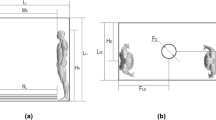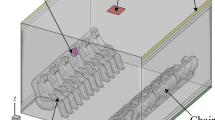Abstract
People in elevators are at risk of respiratory infection because the elevator cabin is crowded and has poor ventilation. The exhaled particles may be inhaled by the susceptible person, deposited on the surface and suspended in the elevator, which can result in direct and indirect transmission. However, whether the air vent designs adopted in the elevator can effectively reduce the transmission risk of respiratory particles remains unknown. In this study, the dispersion of particles under four common ventilation strategies used in the commercial elevator was investigated by proven computational fluid dynamics (CFD) simulations. The flow field was simulated with the RNG k-ξ turbulence model and the Lagrangian method was adopted to track particle trajectories. The effects of air vent layout and airflow rate on particle transmission were analyzed. We found that more than 50% of exhaled particles (average value) were suspended in the cabin and difficult to discharge under the investigated ventilation strategies. The deposited fraction of particles on the susceptible person reached up to 39.14% for infiltration ventilation, which led to a high risk of contact infection. Increasing the ventilation rate could not significantly reduce the inhalation proportion of particles due to the poor airflow distribution inside the elevator. A more proper ventilation strategy should be explored for the elevator to control transmission risk.
Similar content being viewed by others
References
Chen W, Liu L, Hang J, et al. (2023). Predominance of inhalation route in short-range transmission of respiratory viruses: Investigation based on computational fluid dynamics. Building Simulation, 16: 765–780.
Dai H, Zhao B (2020). Association of the infection probability of COVID-19 with ventilation rates in confined spaces. Building Simulation, 13: 1321–1327.
Dai H, Zhao B (2023). Association between the infection probability of COVID-19 and ventilation rates: An update for SARS-CoV-2 variants. Building Simulation, 16: 3–12.
Del Rio C, Malani P (2023). Mpox outbreak update—reply. Journal of the American Medical Association, 329: 428.
Deng Z, Chen Q (2022). What is suitable social distancing for people wearing face masks during the COVID-19 pandemic? Indoor Air, 32: e12935.
Du C, Chen Q (2022). Virus transport and infection evaluation in a passenger elevator with a COVID-19 patient. Indoor Air, 32: e13125.
Duguid JP (1946). The size and the duration of air-carriage of respiratory droplets and droplet-nuclei. The Journal of Hygiene, 44: 471–479.
Guo Y, Dou Z, Zhang N, et al. (2023). Student close contact behavior and COVID-19 transmission in China’s classrooms. PNAS Nexus, 2: pgad142.
ISO (2019). ISO 8100-1 Lifts for the Transport of Persons and Goods—Part 1: Passenger and Goods Passenger Lifts. International Standards Organization.
Leung NHL, Chu DKW, Shiu EYC, et al. (2020). Respiratory virus shedding in exhaled breath and efficacy of face masks. Nature Medicine, 26: 676–680.
Li X, Liu D, Yao J (2022). Aerosolization of fungal spores in indoor environments. Science of the Total Environment, 820: 153003.
Li X, Feng B (2023). Transmission of droplet aerosols in an elevator cabin: Effect of the ventilation mode. Building and Environment, 236: 110261.
Licina D, Pantelic J, Melikov A, et al. (2014). Experimental investigation of the human convective boundary layer in a quiescent indoor environment. Building and Environment, 75: 79–91.
Liu L, Li Y, Nielsen PV, et al. (2017). Short-range airborne transmission of expiratory droplets between two people. Indoor Air, 27: 452–462.
Liu F, Qian H, Luo Z, et al. (2021). The impact of indoor thermal stratification on the dispersion of human speech droplets. Indoor Air, 31: 369–382.
Liu H, Liu Z, Wang Y, et al. (2022a). Distribution of droplets/droplet nuclei from coughing and breathing of patients with different postures in a hospital isolation ward. Building and Environment, 225: 109690.
Liu S, Zhao X, Nichols SR, et al. (2022b). Evaluation of airborne particle exposure for riding elevators. Building and Environment, 207: 108543.
Liu S, Deng Z (2023). Transmission and infection risk of COVID-19 when people coughing in an elevator. Building and Environment, 238: 110343.
Luo Q, Ou C, Hang J, et al. (2022). Role of pathogen-laden expiratory droplet dispersion and natural ventilation explaining a COVID-19 outbreak in a coach bus. Building and Environment, 220: 109160.
Morawska L, Johnson GR, Ristovski ZD, et al. (2009). Size distribution and sites of origin of droplets expelled from the human respiratory tract during expiratory activities. Journal of Aerosol Science, 40: 256–269.
Nazari A, Wang C-C, He R, et al. (2023). Numerical investigation of airborne infection risk in an elevator cabin under different ventilation designs. Physics of Fluids, 35: 63318.
Nishikawa H (2022). A flux correction for finite-volume discretizations: Achieving second-order accuracy on arbitrary polyhedral grids. Journal of Computational Physics, 468: 111481.
Pal A, Biswas R, Sarkar S, et al. (2022). Effect of ventilation and climatic conditions on COVID-19 transmission through respiratory droplet transport via both airborne and fomite mode inside an elevator. Physics of Fluids, 34: 083319.
Peng NN, Chow KW, Liu CH (2021). Computational study on the transmission of the SARS-CoV-2 virus through aerosol in an elevator cabin: Effect of the ventilation system. Physics of Fluids, 33: 103325.
Satheesan MK, Mui KW, Wong LT (2020). A numerical study of ventilation strategies for infection risk mitigation in general inpatient wards. Building Simulation, 13: 887–896.
Tan H, Othman MHD, Kek HY, et al. (2023a). Would sneezing increase the risk of passengers contracting airborne infection? A validated numerical assessment in a public elevator. Energy and Buildings, 297: 113439.
Tan H, Wong KY, Othman MHD, et al. (2023b). Why do ventilation strategies matter in controlling infectious airborne particles? A comprehensive numerical analysis in isolation ward. Building and Environment, 231: 110048.
Wang F, Zhang T, You R, et al. (2023). Evaluation of infection probability of Covid-19 in different types of airliner cabins. Building and Environment, 234: 110159.
Wei J, Wang L, Jin T, et al. (2023). Effects of occupant behavior and ventilation on exposure to respiratory droplets in the indoor environment. Building and Environment, 229: 109973.
Xu C, Liu W, Luo X, et al. (2022). Prediction and control of aerosol transmission of SARS-CoV-2 in ventilated context: from source to receptor. Sustainable Cities and Society, 76: 103416.
Xu C, Ren Y, Li N, et al. (2023). Performance of personalized ventilation in mitigating short-range airborne transmission under the influence of multiple factors. Building Simulation, 16: 2077–2092.
Yan Y, Li X, Fang X, et al. (2023). A spatiotemporal assessment of occupants’ infection risks in a multi-occupants space using modified Wells-Riley model. Building and Environment, 230: 110007.
Zhang Y, Feng G, Bi Y, et al. (2019). Distribution of droplet aerosols generated by mouth coughing and nose breathing in an air-conditioned room. Sustainable Cities and Society, 51: 101721.
Zhang N, Liu L, Dou Z, et al. (2023). Close contact behaviors of university and school students in 10 indoor environments. Journal of Hazardous Materials, 458: 132069.
Zhao X, Yin Y, He Z, et al. (2023). State-of-the-art, challenges and new perspectives of thermal comfort demand law for on-demand intelligent control of heating, ventilation, and air conditioning systems. Energy and Buildings, 295: 113325.
Acknowledgements
This work was supported by the Shandong Provincial Natural Science Foundation, China (No. ZR2021QE027).
Author information
Authors and Affiliations
Contributions
All authors contributed to the study conception and design. Material preparation, data collection and analysis were performed by Liangyu Zhu, Xian Li, Bujin Feng and Fan Liu. The draft of the manuscript was written by Liangyu Zhu, Xian Li and Bujin Feng. All authors commented on previous versions of the manuscript. All authors read and approved the final manuscript.
Corresponding author
Ethics declarations
The authors have no competing interests to declare that are relevant to the content of this article.
Rights and permissions
About this article
Cite this article
Zhu, L., Li, X., Feng, B. et al. Evaluation of transmission risk of respiratory particles under different ventilation strategies in an elevator. Build. Simul. 17, 771–784 (2024). https://doi.org/10.1007/s12273-024-1102-0
Received:
Revised:
Accepted:
Published:
Issue Date:
DOI: https://doi.org/10.1007/s12273-024-1102-0




